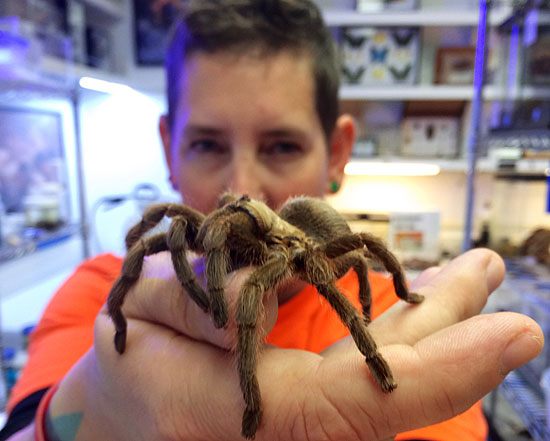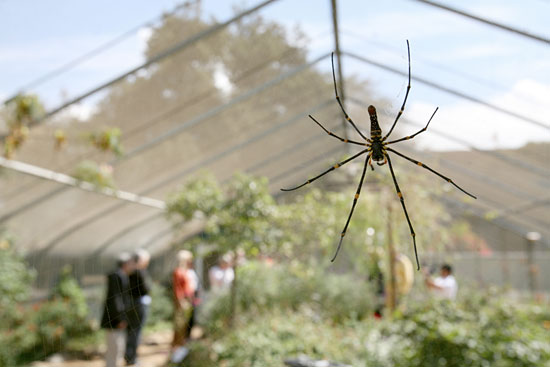The amazing spider woman
October 17, 2014
Cat Urban is L.A. County’s very own spider woman. You won’t find her swinging from tall buildings to fight crime, but she just might help you feel a little safer at night.
As supervisor of invertebrates at the Natural History Museum, it’s Urban’s job to manage all things creepy and crawly—including the orb-weavers that are currently stretching their spiral-shaped webs across the spider pavilion.
Fear of spiders is said to be the most common phobia in the world (look no further than Halloween decorations and Hollywood movies for confirmation), but Urban says the creatures are misunderstood.
“They don’t want anything to do with us,” Urban says. “They’re more like ‘I’m going to run away from this giant monster that ran into my web.’ ”
The orb-weavers in the pavilion are technically blind, so they can’t see people and they don’t detect them as prey. As a rule, spiders also need to conserve their venom to anesthetize prey—it takes a lot of energy to produce. So it’s a fair bet that they will avoid wasting it by biting humans or other creatures they can’t consume.
On the other hand, the eight-legged creatures are an important part of our ecosystem and the food chain, serving as meals for reptiles, birds and amphibians. And their own dining habits are something to applaud.
“They eat a ton of bugs,” Urban says. “The world would be overrun with flies and mosquitos if we didn’t have orb-weavers; they are essential to our livelihood on the planet.”
That usefulness notwithstanding, people frequently get so creeped out that they have to make an early exit from the pavilion. Even Urban’s older brother is “petrified” of spiders—a major motivating factor behind her interest in the creatures, which began when she was a 12-year-old in Texas.
“There was this special place right across from my house where they were everywhere,” Urban said. “It was this huge community of nephila—they’re the ones that make the big webs that are always right across the path when you’re jogging or biking.”
Urban spent six years at the Smithsonian Institution in Washington, D.C. before moving to Los Angeles. One of the main reasons she came was the spider pavilion, which she said is the only one of its kind in the world.
The pavilion is open daily from 10 a.m. to 5 p.m. until November 2. Entrance is $5 for adults and $3 for children, in addition to general museum admission. Advance reservations are recommended.
Those brave enough to enter will be treated to a dazzling display by hundreds of orb weavers, from the Giant Wood Spider, which builds webs that can measure up to ten feet in diameter, to Golden Silk Spiders, whose yellow webs contain silk that’s as strong as steel. Other arachnids such as tarantulas, wolf spiders and jumping spiders are showcased in a newly-redesigned indoor exhibit adjacent to the pavilion.
Urban and her fellow museum workers will be on hand to educate the public and answer any spider-related questions. Each morning they must adjust the visitors’ path through the pavilion to accommodate new webs that were built overnight, and they also deliver fresh meals like crickets, blowflies and roaches directly to the spiders’ webs.
While Urban has no qualms about letting a spider the size of a bread plate crawl up her arm, she’s not completely fearless—zombies, she says, give her the heebie-jeebies. Which is a much more rational thing to fear, of course.
Posted 10/17/14
















 405 bridge work causes a stink
405 bridge work causes a stink